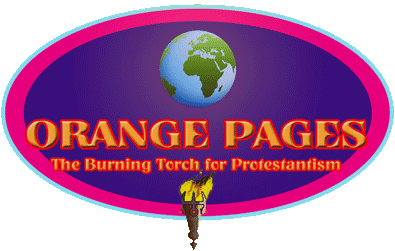
|
|
 |
|
|
|
THE ORANGE ORDER AND THE CANADIAN SCENE |
|
Orangeism, born as it was in great tribulation, encountered many difficulties in its formative years. There are no available records that can confirm where or by whom the first Orange Lodge in Canada was instituted. One must keep in mind the history of Orangeism and the settlement of Canada which provided a far different background to that prevailing in the old land during the its early days. Many new settlers were glad to be away from the extremities of persecution and in some cases, poverty of the homeland while others were concerned that the oppression of liberty - whether civil or religious, should not be allowed to raise its head in the Land of the Maple Leaf. Most historians agree that Orangemen were in Canada previous to 1812 and by 1822 the 12th Parade in Toronto had become the most popular event of the day. Ogle Robert Gowan, the Order's first Canadian Grand Master is recognized as the founder of Canadian Orangeism. As a recent new-comer to Canada, the territory the Grand Lodge was intended oversee, he brought to his adopted land a conviction that a Branch of Orangeism should be nurtured and cultivated in Canada as a recognized organization. Its birthplace was Brockville, Ontario, a centre of Protestant and Loyalist settlers dedicated to maintaining their religious convictions and loyalty to British Institutions symbolized by their flag - the Union Jack. Prior to that year, lodges of the Orange Order had operated as independent units, planted in Upper and Lower Canada, principally by pioneers who brought with them, from the British Isles, "Certificates of Membership," some by settlers retired from military service where Orange Lodges had existed within units such as the Fourth Regiment of Foot - known generally as King William's Regiment. As early as 1808 there is evidence that an Orange Lodge existed in Ontario, and a transfer certificate issued by L.O.L. 109, County Armagh in Ireland, had found its way to the loyal province. In New Brunswick there is a record of a lodge meeting in 1783 under a Charter issued in 1694 bearing the name of Colonial Patent No. 6, issued from the Guild Hall, London, giving authenticity to information that a number of Societies or Clubs under the name of "Orange" existed since the arrival of William, Prince of Orange, in England in 1688. WAR SERVICE Canadian Orangemen were first to the colours in time of war in their allegiance to the Crown and Canada as an integral part of British identity. Orangemen participated in the War of 1812-1814; the Upper Canada Rebellion of 1837-38; the Fenian Raids of 1866; the Riel Rebellions of 1870 and 1885; the South African (Boer War); and the Two World Wars of 1914-18 and 1939-45. During the Rebellion of 1837 Gowan served as Commanding Officer of the Queen's Royal Borderers and was wounded at the Battle of the Windmill near Prescott, Ontario. Orange Halls throughout rural Ontario and elsewhere were used as common recruiting despots during World Wars I and II and history records that many thousands of its youngest members paid the Supreme Sacrifice with some being recognized as recipients of the Victoria Cross.
|
 |
 |
 |
 |
 |
 |